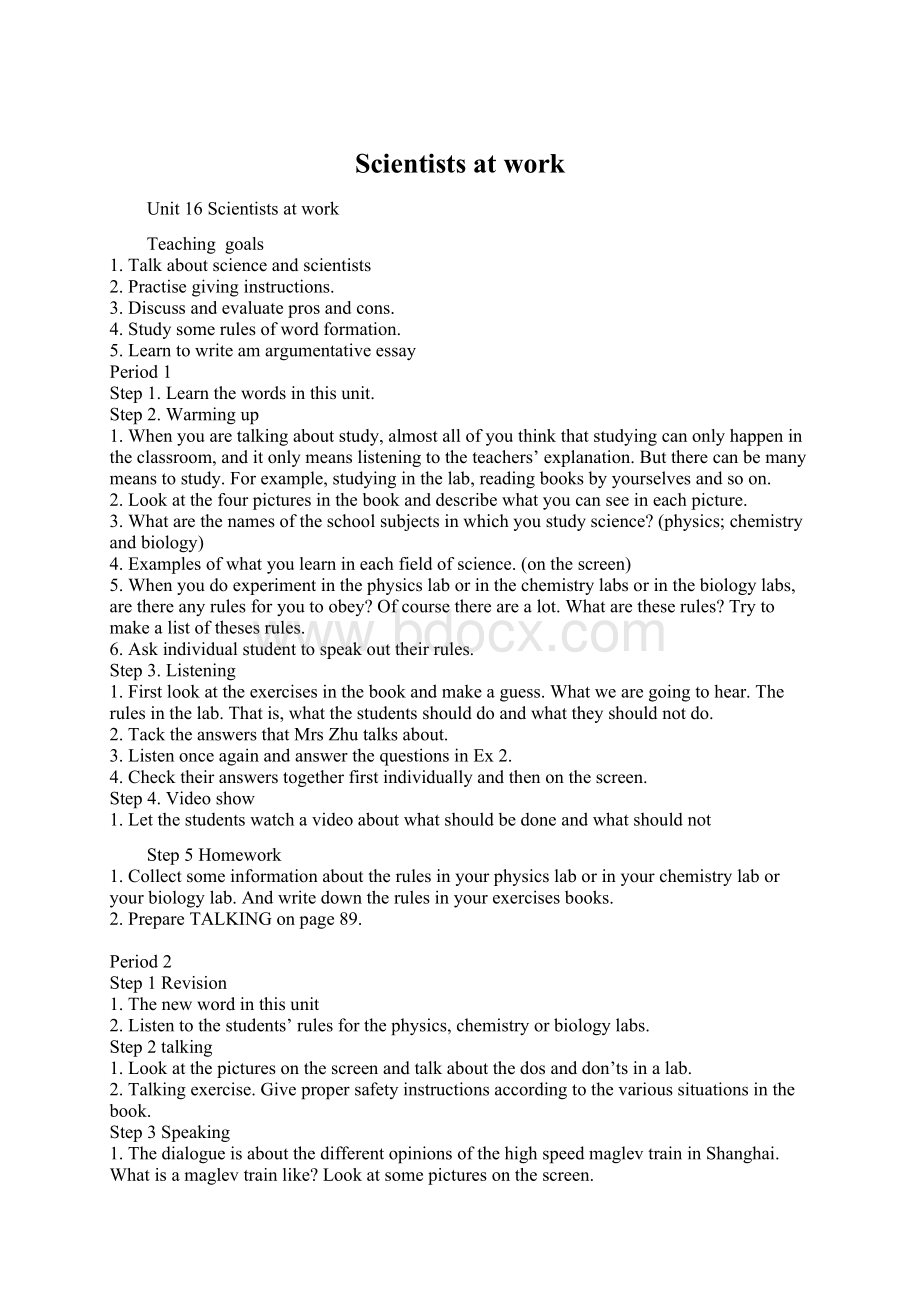Scientists at work.docx
《Scientists at work.docx》由会员分享,可在线阅读,更多相关《Scientists at work.docx(8页珍藏版)》请在冰豆网上搜索。

Scientistsatwork
Unit16Scientistsatwork
Teachinggoals
1.Talkaboutscienceandscientists
2.Practisegivinginstructions.
3.Discussandevaluateprosandcons.
4.Studysomerulesofwordformation.
5.Learntowriteamargumentativeessay
Period1
Step1.Learnthewordsinthisunit.
Step2.Warmingup
1.Whenyouaretalkingaboutstudy,almostallofyouthinkthatstudyingcanonlyhappenintheclassroom,anditonlymeanslisteningtotheteachers’explanation.Buttherecanbemanymeanstostudy.Forexample,studyinginthelab,readingbooksbyyourselvesandsoon.
2.Lookatthefourpicturesinthebookanddescribewhatyoucanseeineachpicture.
3.Whatarethenamesoftheschoolsubjectsinwhichyoustudyscience?
(physics;chemistryandbiology)
4.Examplesofwhatyoulearnineachfieldofscience.(onthescreen)
5.Whenyoudoexperimentinthephysicslaborinthechemistrylabsorinthebiologylabs,arethereanyrulesforyoutoobey?
Ofcoursetherearealot.Whataretheserules?
Trytomakealistofthesesrules.
6.Askindividualstudenttospeakouttheirrules.
Step3.Listening
1.Firstlookattheexercisesinthebookandmakeaguess.Whatwearegoingtohear.Therulesinthelab.Thatis,whatthestudentsshoulddoandwhattheyshouldnotdo.
2.TacktheanswersthatMrsZhutalksabout.
3.ListenonceagainandanswerthequestionsinEx2.
4.Checktheiranswerstogetherfirstindividuallyandthenonthescreen.
Step4.Videoshow
1.Letthestudentswatchavideoaboutwhatshouldbedoneandwhatshouldnot
Step5Homework
1.Collectsomeinformationabouttherulesinyourphysicslaborinyourchemistrylaboryourbiologylab.Andwritedowntherulesinyourexercisesbooks.
2.PrepareTALKINGonpage89.
Period2
Step1Revision
1.Thenewwordinthisunit
2.Listentothestudents’rulesforthephysics,chemistryorbiologylabs.
Step2talking
1.Lookatthepicturesonthescreenandtalkaboutthedosanddon’tsinalab.
2.Talkingexercise.Givepropersafetyinstructionsaccordingtothevarioussituationsinthebook.
Step3Speaking
1.ThedialogueisaboutthedifferentopinionsofthehighspeedmaglevtraininShanghai.Whatisamaglevtrainlike?
Lookatsomepicturesonthescreen.
2.Listentothetapeaboutthedialogue.Andlearntotalkaboutadvantagesanddisadvantagesofahigh-tech.
3.Howtotalkaboutadvantagesanddisadvantages?
Lookattheusefulexpressionsinthebook..Studentsreadthesentencestogther.
4.Discussingroupsabouttheadvantagesanddisadvantagesabout“cloning;nuclearenergy;computersandspaceflights”.
5.Listentothestudents.
Step4Homework
1.Oralhomework:
Prepareadialogueaboutadvantagesanddisadvantageofahigh-tech,makingadebateorargument.
2.Previewthetext.
3.FindoutsomeinformationaboutBenjaminFranklinandsaysomethingabouthiminthenextclass.
Period3
Step1Revision
1.Listentothestudents’debatesaboutacertainkindofhigh-tech,suchascloning,nuclearenergy;computer,orspaceflight.
2.Checkthestudents’memoryabouttheusefulexpressionsinthebook.
Step2.ACompetition
1.Checkthestudents’commonsenseaboutsomefamousscientistsandwhatinventionsdidtheymake.
2.TalkaboutBenjaminFranklin
Step3Reading
1.Fastreadingandlistening:
letthestudentstoreadandlistentothetapetodecidetrueorfalsestatementsaboutthetext.(onthescreen)
2.Skimming:
letthestudentreadthetextagainandfindoutsomedetailsaboutthetext.(onthescreen.)
3.Readthetextforathirdtimeandchoosethebestchoices.(onthescreen).
4.theanalyzesofthewholepassage
Threeparts
Para1—3:
thedescriptionoftheexperiment
When:
onarainydayinJune,1752
Where:
inashedinthefields
Who:
Franklinandhisson
What”:
akiteexperiment
Why:
toprovelightningandelectricityarethesame
Para4:
theneededmaterials
Asilkhandkerchief:
Piecesoflightwood:
tomakeakitetocarrythething
intothesky:
String
Akey:
tofeeltheelectricshock
Thunderstorm:
toproducelightning
Acondenser:
tocollectandstoreelectricity
Para5—6thestepsoftheexperiment
Step1:
fixapieceofsharpmetaltothekite
Step2:
fastenakeytotheendofthestring.
Step3:
tiearibbontothestring
Step4:
flythekitewhenathunderstormappears.
5.AnswerthequestionsinpostreadingEx2.
Step4Homework
1.Readthetextandtrytoretellit.
2.Findoutthedifficultwordsandexpressionsinthetextandrefertosomereferencebooks.
Period4
Step1Revision
1.Listentothestudents’retellingthetext.
2.Dictatesomesentences:
(oneswritesontheBb)
(1)Intheeighteenthcentury,BenjaminFranklinconductedanumberofexperimentsinwhichheshowedwhatelectricityis.
(2)HavingrealizedthatIcoulduseakitetoattractlightning,Idecidedtodoanexperiment.
(3)Thestringwasgettingcharged.
(4)Mostkitesaremadeofpaper,butakitemadeofsilkwillnottearsosooninweatherwithrainandstrongwinds.
(5)Tiethecornersofthehandkerchieftothepointsofthecross,andyouwillhaveanicestrongkite.
(6)Fixaverysharppieceofmetal,pointingafootormoreabovetheframe,tothetopofthelongerstickofthecross.
(7)Flythekitewhenathunderstormappearstobecomingon.
Step2languagepoints
1.AnalyzetheabovesentencesandtranslatethemintoChinese.
2.somewords:
(1)successful----besuccessfulin(doing)sth;succeedindoingsth;
dosthsuccessfully;havesuccessindoingsth
Wereyousuccessfulinpersuadinghimtochangehismind.
Hewassuccessfulinpolitics.
Hesucceededingettingwhathewanted.
(2)conduct----
Thewaiterconductedthecustomerstothedoor.(leadorguide)
Whoconductedthisconcerttoday?
(directtheperformanceof)
Copperconductselectricitybetterthanothermaterials.(allowheatorelectricitytopass)
Thereporterwascriticizedforhisconduct.(behavior)
(3)charge-----
Ittakesfourhoursformycellphonetogetcharged.(storeelectricity)
Theycharged2000yuanforthesuit,butIcanonlypay800yuanforit.(askasaprice)
Thechildrenchargeddownthestairs.(rush)
Hewaschargedwithmurder.(accusesbofsth)
(4)prove----Giveproofof;showtobetrue
Hehasprovedhiscourageinthebattle.
Factsprovedthatwhatyousaidwascompletelywrong.
Itprovedthatheisacheat.
Heprovedhimselftobecapable.
Thereportproved(tobe)true.(被证明是)
Thedrugproveshelpful.
(5)tear
Itoremyshirtonanail.=Anailtoreaholdinmyshirt.
Shetorethewrappingoffthepresent.
Hegotsoangrythathetoretheletterintopieceswithoutfinishingreadingit.
Theyaretearingdowntheoldhousestobuildnewbuildings.
Hereyesfilledwithtears.
主动形式表示被动意思;连用副词well;easily
sell;wash;write;read;last;tear;wear
Thebooksellswell.
Silkwasheseasily.
Hispenwritessmoothly.
Jeanswear/lastlong/well.
Papertearseasily.
Hispoemsreadwell.
Thiskindofclothwearslong.
(6)control
Ihavenocontroloverhim.
Soonthefirespreadandgotoutofcontrol.
Hecontrolledhisangerandexplainitagainpatiently.
incontrol;outofcontrol;undercontrol;losecontrolof
(7)sense
Hehasakeensenseofhearing.
Shehasnosenseofhumor.
I’measytolosemywaybecauseIhavenosenseofdirection.
(8)doubt
Idoubtedmytwoeyes.
Idoubtedwhetherthestorywastrue.
Idoubtwhetherhewillappear.
Idon’tdoubtthatwewillwinthegame.
Thereisnodoubtabouthisabilityforthejob.
Itisbeyonddoubtthathewillhelpus.
3.Phrases:
(1)inone’sopinion
(2)makeuseof利用
(3)anumberof许多
(4)conduct/do//make/tryanexperiment作试验
(5)flyakite放风筝
(6)get/becomecharged充电
(7)electricshock电击
(8)agreatdealof大量的
(9)tie…to/fasten…to把…绑在…上
(10)add…to给…增加
(11)pointto指向pointat指着
(12)takeare小心
课文疑难解析
1.Thisnewtrainhasnowheelsandnoengine.这种新型火车没有轮子,也没有发动机。
(Speaking;page23)
否定句用and连接时,第二个否定词no(not/never)等不宜省略。
and也可以改为or,但此时一般用前一个否定词即可。
如:
Thereisnoairandnowater(=noairorwater)onthemoon.月球上没有空气,也没有水。
Heneversmokesandneverdrinks.(=Heneversmokersordrinks.)他从不抽烟,也不喝酒。
2.Hereishowhedescribedoneofhisexperiments.下面是他对自己的一个实验的描述。
(Reading,Paragraph1)
here常位于句首,用于引起对某物或某人的注意或用于把某物给某人,后常接倒装语序。
如:
It’steno’clockandhereisthenews.现在是十点钟,下面报道新闻。
Herecomesthebus!
公共汽车来啦!
—Ileftmycameraathome.我把相机放在家里了。
—Hereyouare!
Usemine.给你,用我的吧!
3.HavingrealizedthatIcoulduseakitetoattractlightening,Idecidetodoanexperiment.在意识到可以使用风筝捕捉闪电之后,我决定做一个试验。
(Reading;Paragraph2)
Havingrealizedthat…在这里是现在分词短语作时间状语,相当于AfterIhadrealizedthat…。
注意分词的逻辑主语应与句子的主语保持一致,即realized的主语也是I。
如:
Havingfinishedhishomework,Jackranouttoplaybasketball.做完家庭作业之后,杰克跑出去打篮球。
Havingbeengivensuchagoodchance,hewouldn’tgiveituptoothers.大家给了他这么好的一个机会,他不会把机会让给别人。
4.Iwasbeginningtothinkthattheexperimentwouldnotwork.我开始认为试验可能行不通。
(Reading;Paragraph3)
(1)beingtodo/doingsth:
开始下雨了。
ShebeganlearningEnglishfiveyearsago.她五年前开始学习英语。
(2)work:
vi.
①工作,从事
Sheworksinafactory.她在工厂工作。
Ispentthewholeweekendworkinginthegarden.我整个周末都在花园里干活。
②(计划、机器等)运作,进行顺利
Doesthislightwork?
这盏灯亮吗?
Yourideawon’tworkinpractice.你的想法在实际中行不通。
5.Thisexperimentprovesthatlightningandelectricityarethesame.这个实验证明了闪电与电是相同的。
(Reading,Paragraph3)
prove意为“证实;证明”,常用作及物动词,后接名词或that从句或复合宾语;也可用作系动词,后接形容词或动词不定式,意为“证明是;显示出是”。
如:
Inordertoproveherpoint,sheshowedthemthelatestsalesfigures.为了证明她的观点,她给她们看了最新的销售数字。
Thefingerprintsonthegunprovedthatshewasthemurderer.枪上的指纹证明她就是凶手。
Theyprovedher(tobe)guilty.他们证明她有罪。
6.Thestringwasgettingcha